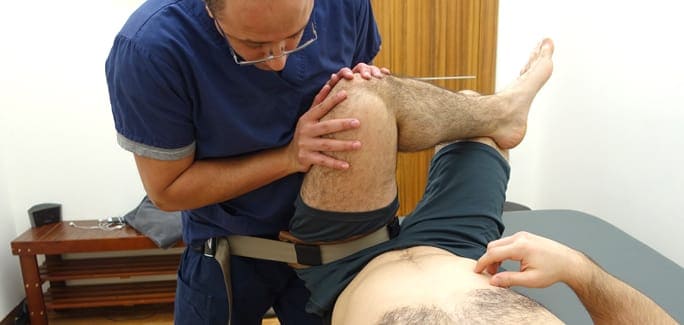Hip trouble may occur as a result of any one of a number of conditions and injuries associated with the pelvic area, including hip bursitis, labral hip tear, and hip flexor strain. Because the hip is centrally located and pivotal to the movement and function of the lower half of the body, injury to the hip may have serious repercussions beyond the immediate site of injury. Minors who struggle with hip pain are more likely to develop pain in the back and the joints of the lower extremities. Those who play sports, whether professionally or recreationally, are also more prone to hip injuries. Between 10 and 24 percent of injuries sustained by children while playing sports are hip-related. For all these reasons, proper diagnosis and treatment of hip pain is essential.
The largest joint in the body, the hip acquires its stability from its unique design. Because it’s a ball-and-socket joint, a special kind of joint in which the rounded surface of a bone fits neatly into the groove of another bone, it has a wider range of motion and flexibility than many other joints in the body. In the case of the hip joint, the rounded end of the thigh bone (the femur) fits into the cup-like hole of the acetabulum, the concave surface of the pelvis.
The acetabulum is a deep depression. This is important because it gives the hip joint a stability it wouldn’t have otherwise. Surrounding the head of the femur (the “femoral head”), the acetabulum helps to prevent the hip from becoming dislocated. This depression is surrounded by a rim of cartilage, the acetabular labrum, which provides a larger articular surface. This, in turn, further stabilizes the joint.
The hip region is also home to a complex, interconnected network of muscles. The quadriceps and hamstrings work in opposition to move the hip joint while stabilizing the knee. Importantly for our discussion, the three hip flexor muscles work together to flex the legs, bringing them close to the trunk. These three muscles, the iliopsoas, rectus femoris, and sartorius muscles, are vitally important in common activities like running, jumping, and cycling.
Covering the femoral head and acetabulum is a layer of articular cartilage, a rubbery substance that prevents the joints from rubbing together during movement. Also assisting in preventing friction are the bursae, tiny sacs filled with fluid resting between the tendons and bones of all the major joints. The most significant bursa in the hip is the trochanteric bursa. If it becomes inflamed, trochanteric bursitis can develop.
A proper diagnosis is critical for hip pain treatment. In most cases, bursitis occurs as a result of biomechanical abnormalities. When these abnormalities become a fixed part of a person’s gait over an extended period, they can lead to overuse injuries. For example, over-pronation (a flattening or rolling inward of the foot) can create the conditions that result in inflamed bursae. In other cases, the bursae may be injured as a result of traumatic injury.
Two of the most common types of hip bursitis are trochanteric and iliopectineal bursitis. The iliopectineal bursa, the largest bursa in the body, is associated with sports that greatly depend on the hip flexors: for example, soccer, ballet, and uphill running. Damage to this bursa can tremendously hinder the enjoyment of sports and may require groin pain treatment because of severe groin pain radiating to the thigh or anterior hip, pain so intense it may disrupt normal gait.
Trochanteric bursitis is also characterized by intense pain, though in this case the pain radiates into the lateral buttock. Patients may experience pain while standing for long periods and while climbing or running, necessitating bursitis hip treatment.
Although the labrum is designed to deepen and stabilize the acetabulum, it can also suffer damage as a result of trauma. This may happen when an athlete twists or dislocates his or her hip. Labral tears are sometimes seen in patients suffering from the effects of osteoarthritis. Symptoms of a tear may include painful clicking, a feeling that the hip is giving way beneath the patient, and pain that increases when the leg is extended. Hip labral tear treatment is generally conservative: in addition to resting, a patient may seek physical therapy and anti-inflammatory medications under the supervision of a physician.
Treatment for hip bursitis is almost always non-surgical. In the case of iliopectineal bursitis, it consists of rest, icing, and stretching of the iliopsoas. A physician may also recommend non-steroidal anti-inflammatory medication. If, however, the flexor muscle fails to respond to conservative bursitis treatment, hip injections may be necessary. The injection of corticosteroids will reduce inflammation, thereby minimizing tissue damage. In the case of trochanteric bursitis, treatment should begin with icing and heating. Phonophoresis may be used to help administer drugs through the skin to the site of injury, thus helping to control inflammation. These should be accompanied by an exercise program that includes hip abductor and core strengthening exercises. As with iliopectineal bursitis, corticosteroid injections may be necessary in more severe cases.
The iliopsoas muscle may suffer injury when a patient’s thigh is forced into extension, or blocked during flexion—as, for example, when a soccer player extending his or her leg for a kick is struck in the leg. Groin pain may develop as a result. Hip flexor pain treatment begins with rest. Gradually the patient should begin a regimen of rehabilitation within reasonable limits. If the hip flexor is torn, he or she may need to wait between four to six weeks before returning to sports.
At NYDNR we specialize in treatment of walking and running disorders. We are the first full technological gait (analysis) outpatient facility in NYC. Our C.A.R.E.N (computer assisted rehabilitation environment) is the first privately owned system in US. C.A.R.E.N’S uniqueness lies in ability to provide multisensory feedback while patient is walking, standing or balancing on one leg. C.A.R.E.N’S analytical ability allows diagnostically precise monitoring and correction of patient’s movement. We are the only clinic certified in DNS (dynamic neuromuscular stabilization) method. DNS has been remarkably successful with treatment of hip disorders, which have not responded to other physical therapy methods. For those suffering from hip bursitis and tendinosis we provide ESWT ( extracorporeal shockwave therapy)






























































